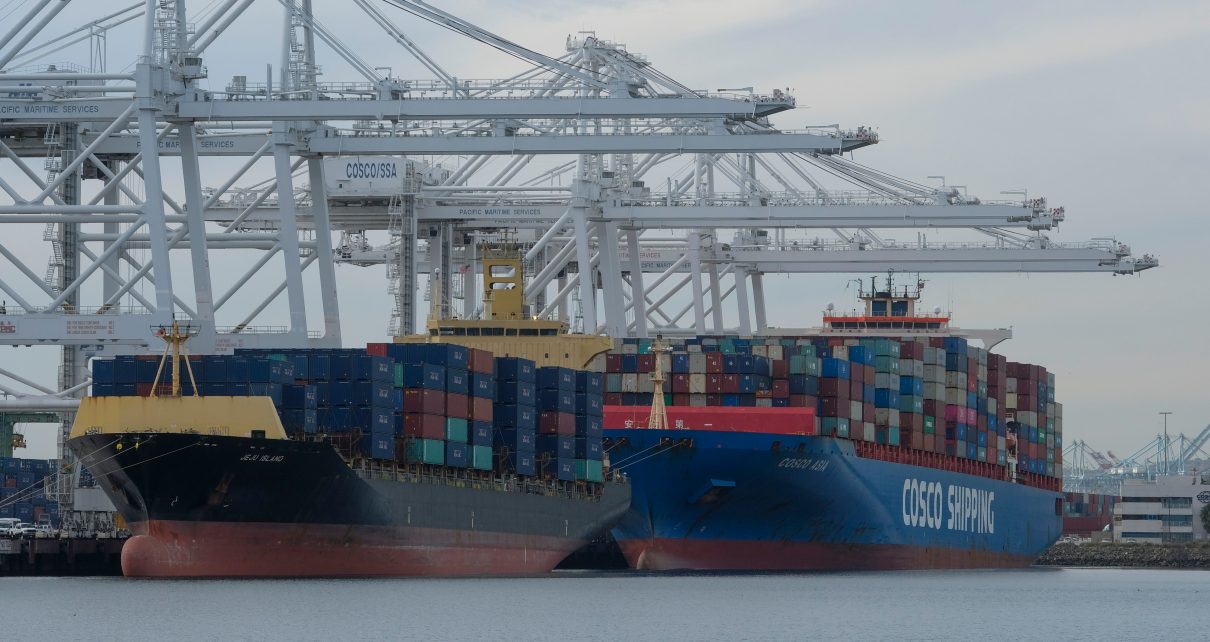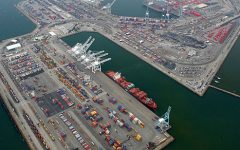
Cargo ships stacked with shipping containers are docked at the Port of Long Beach. Calif., Jan. 2022. (Photo: Ringo Chiu, Shutterstock)
Ports of LA, Long Beach Free Of Cargo Backup First Time Since October 2020
The port backlog crisis in SoCal has officially ended
By Evan Symon, November 24, 2022 2:30 am
The Marine Exchange of Southern California announced that the backup of container ships that began in October of 2020 had officially ended, with the number of waiting cargo ships at the Ports of Los Angeles and Long Beach reaching zero.
A sudden increase of shipping trade in the second half of 2020 following a large lull caused by COVID-19 pandemic related restrictions, caused the initial logjam to begin in October 2020. However, year later, this catchup on cargo was suddenly compounded by many dockworkers leaving during the Great Resignation, a lack of equipment, poor trucking regulations, outdated port rules and regulations, other supply chain problems and lingering after effects of the COVID-19 pandemic. Between October 2021 and January 2022, over 100 ships were in the Pacific Ocean waiting to get into one of those ports.
Governor Gavin Newsom signed an Executive Order, followed by state and local actions passed and signed into law in late 2021 that helped create more cargo space, create better flow and ease of movement for all steps of the unloading and trucking processes, and identify the best routes for trucks to take helped alleviate the number of waiting cargo ships, with a new hiring spree reducing the number of waiting ships even further. Cargo companies began feeling the financial pinch as well with such actions such as charging the companies for cargo containers left uncollected for too long and diverting the cargo to other ports.
The number of waiting ships gradually fell throughout the year, with many being greeted by the new improvements to the ports designed to unload and turnaround ships very quickly. With the number finally hitting zero again this week, port officials were relieved at the end of one of the largest cargo backups in history.
“It is time to move into a different phase of operations and declare that the backup has ended,” said Marine Exchange of Southern California executive director Kip Louttit on Tuesday.” Both ports have enough labor to handle the current volume of ships while some ocean carriers are delaying vessel arrivals to better suit their own operations.”
While some backups continue to exist at other U.S. ports, with the Port of Savannah in Georgia being especially hard hit right now with backups, shipping experts noted to the Globe on Wednesday that the whole industry is now breathing easier with the SoCal ports now free of any backup.
“When we first had the backup in California, Trump was still President,” explained George Pinsky, a Cleveland based shipping consultant, in an interview with the Globe. “It took that long to clear it. That sort of thing just should not happen, but a lot of things not working out right did just that.”
“These ports need to keep these improvements in place though, and not just slowly dismantle them, because then it could happen again. A lot of Great Lakes ports got rid of a lot trucking routes in the 80’s and 90’s due to their being less use, but then had to contend with truck backups, much like California’s when cargo coming in went up, largely because they got rid of some needed things. Southern ports had the same thing happen in the same time period during a lull in oil prices hitting the roof. Just because there aren’t any backups now doesn’t mean issues in the future won’t happen again and need them to run smoothly.”
“Still, all in all, no more backup is good news for Los Angeles and Long Beach, as many Asian countries will likely now move cargo back there, including China once all the lockdowns are done, which cause a significant bump in traffic.”
As of Wednesday, there are no plans for reducing any of the implemented actions that helped reduce cargo congestion at the ports.
- Bill to Require Law Enforcement Disclosure if AI Was Used To Help Write Reports - August 7, 2025
- Gov. Newsom Files FOIA Request To ‘Expose True Cost’ Of L.A. Federal Troop Deployment for Anti-ICE Riots - August 6, 2025
- California Redistricting: How Newsom’s Plan Will Demolish Hard Fought GOP Gains - August 6, 2025



Shippers will continue to avoid California ports as long as the Democrat cabal who controls California makes it difficult to unload and distribute shipments by imposing mandates from unelected bureaucrats from state agencies such as the Air Resources Board that will ban gas and diesel trucks by 2035.
Google search: “This includes mandating that all new trucks operating around busy railways and ports be zero-emission vehicles by 2024”. Can’t wait. That’s a little more than a year away. If you need to buy something substantial, you have a year in which to buy it.
Backup isn’t gone.
What does shipping consultant George Pinsky think all those ships anchored today out in the ocean off Hunting Beach and Long Beach are waiting for if the backup has cleared? They’re clearly waiting for something, and it isn’t for the wind to come up.
… should read “HuntingTON Beach”. Damn spell correct strikes again!
Maybe they’re waiting to transport all the money that the Biden regime is sending to China, Ukraine and all the other bad actors to launder their FTX liquidation proceeds….
The port should implement newer technology to monitor incoming / outgoing TEU faster by let’s say utilizing drones, better allocation software and quick unit recovery. Working more hours and developing more land will help but isn’t the final solution. There are automated processes used around the globe in other ports to speed up turnover.